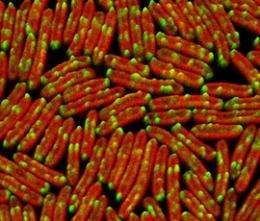Biological switch paves way for improved biofuel production

(Phys.org) -- Scientists from Queen Mary, University of London have discovered a mechanism that controls the way that organisms breathe or photosynthesise, potentially paving the way for improved biofuel production.
Writing in the journal PNAS, Dr Lu-ning Lu and Professor Conrad Mullineaux from Queen Mary's School of Biological and Chemical Sciences report that by exposing cells to different light conditions, they have changed the way in which electrons are transported.
Professor Mullineaux explains: "Any organism that breathes or photosynthesises depends on tiny electrical circuits operating within biological membranes. We are trying to find out what controls these circuits: what makes the electrons take the routes that they do, and what switches are available to send the electrons to other destinations?"
Cyanobacteria are a kind of bacterium that both breathes and photosynthesises and therefore has a complicated set of different possible electron transport pathways.
The team put specific fluorescent tags on some of the protein components involved in electron transport, and then viewed the live cells with a fluorescence microscope to see where those complexes are in the cell.
By studying the cells in this way, the team visualised a biological electrical switch in action. When they changed the conditions (for example by making the light brighter or dimmer), the cell responded by changing the position of the complexes, which leads to major changes in the pathways of electron transport.
Full understanding of these mechanisms could help with re-engineering of cyanobacteria for improved solar-powered biofuel production, for example.
Journal information: Proceedings of the National Academy of Sciences
Provided by Queen Mary, University of London















